Recommendations for choosing wallpaper for the hall
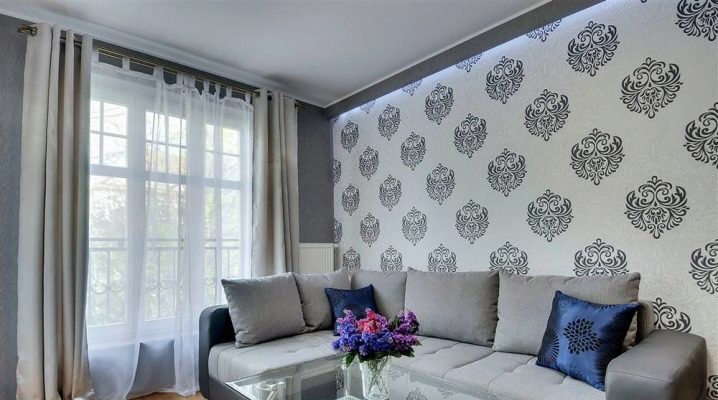
Repair is always a very responsible business. But the most important thing is to create an attractive living room. The hall is the place where the owners of the house receive guests. A significant part of the time is also spent here. That is why the selection of high-quality correct wallpaper for this room is a very important point.
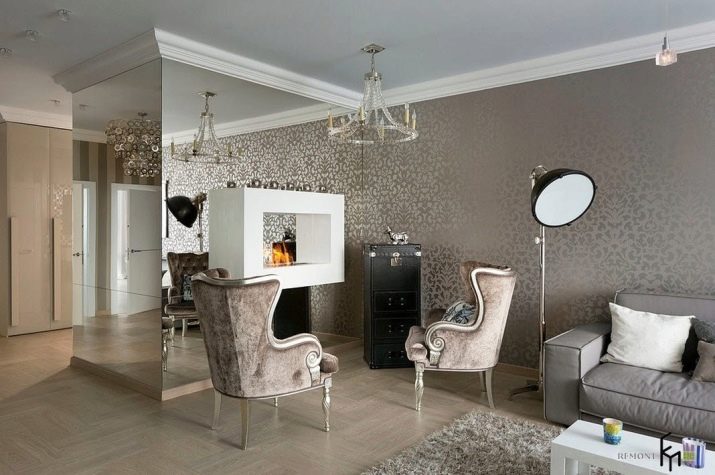
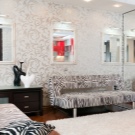
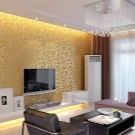
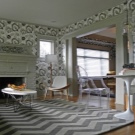
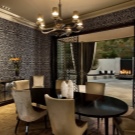

Types and samples
If the owners are mistaken with the choice of wallpaper for the living room, they will be very uncomfortable in it. Why exactly wallpaper, the answer to this question is simple. Designers and builders agree that other finishes are inferior to wallpaper as the most comfortable finishing option. It is thanks to them, whatever they are, that you can create a very cozy living room in which it will be pleasant to be. In addition, the widest variety of choices for interior design can be noted among the wallpapers.
When the choice is made of what material will become the main one for finishing, you need to decide on other parameters that relate directly to the wallpaper itself. There are a great many of them.
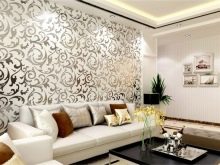
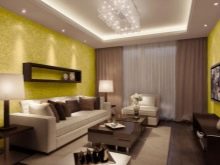
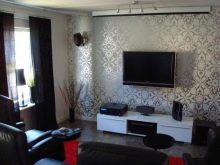
In the hardware store, you can buy options for the classic style, high-tech and even wallpaper for the "rustic" hall. Recently, there is no particular style that is more popular than others. As a rule, several options are at their peak at the same time. For example, customers of wallpaper stores are often interested in classics.
Even if someone decides to repeat someone else's interior, it is still unlikely to work, because in each particular room the wallpaper looks different. This should be considered when buying.
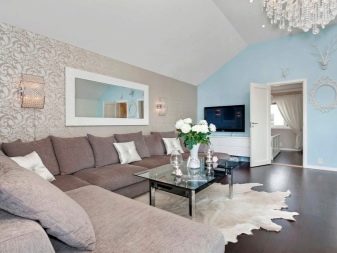
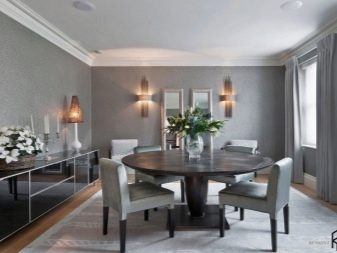

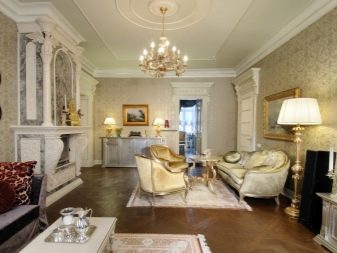
Often, apartment owners decide to glue the wallpaper on their own, without calling the decorators. This is only a good idea if homeowners know how to handle any kind of material that wallpaper is made from. And they can be paper, bamboo, and textile. More details about the materials are given in the article below.
Independent work will significantly save money, but it can spoil the appearance of the apartment if you approach the matter carelessly and do not study the instructions on how to do this.
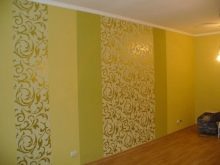

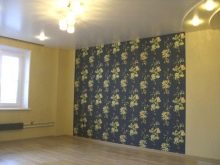
Material
When the question arises that it is time to make repairs in the hall, then first of all you need to decide on what material will be used for decoration. The living room is, as a rule, a little polluted room, so the soiling indicator is not so important.
But having chosen in advance what material the finishing materials will be made of, you can roughly calculate what the expenses will be.
In general, you can buy wallpaper from a variety of materials for decorating the walls of the living room. Restrictions are set only based on the repair budget. Among the huge variety, everyone will find what he needs, both in appearance and in value. Manufacturers of this type of finishing materials take into account fashion trends and wallpaper production technologies.
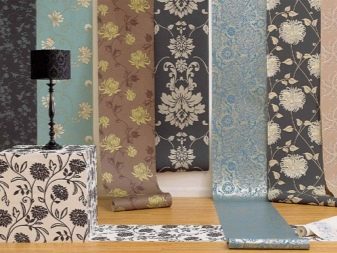

Thanks to technological progress, more and more unusual wallpapers appear on the building materials market, which are gradually gaining popularity. But it is important to consider more familiar materials before renovations begin in the living room. So, roll finishing materials are:
Paper
This is the most common type of wallpaper. It is the cheapest. Paper canvases are very easy to glue, but they have their drawbacks. So, for example, they need to be protected from water and general moisture, as well as from sunlight, since over time, the finish may lose color, and the pattern on them will not be visible.
Despite these shortcomings, they are quite suitable for the living room, because this is not a kitchen, where humidity rises regularly and there is a risk of splashes.
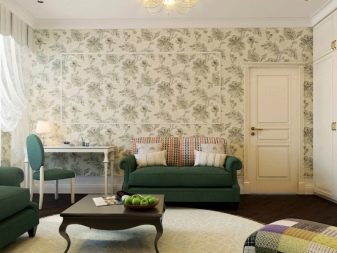
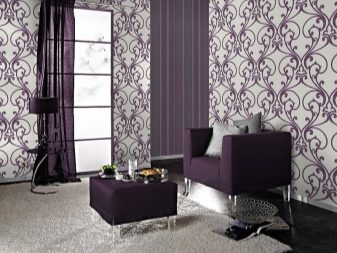
This coating option has the longest history of development. The origin of paper wallpaper is China. From East Asian countries, they came to European countries only in the 18th century. Since that time, wallpaper has become very popular, and now it is not easy to find at least one apartment in which such materials for decoration would never have been used.
Such materials are made not only smooth, but also structural. As a rule, all of them can be divided into two conditional categories: in two layers (duplex) and in one layer (simplex). The first option, as a rule, has a protective coating, which is created in order to protect it from environmental influences. It is the two-layer paper models that are very popular now. In any case, this coating for the surface of the walls will properly serve the owner for at least five years after they are glued.
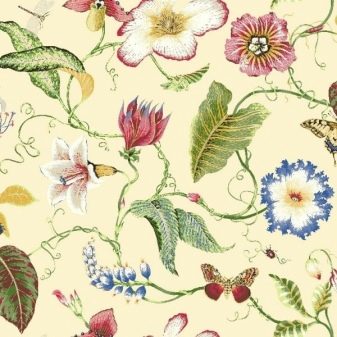
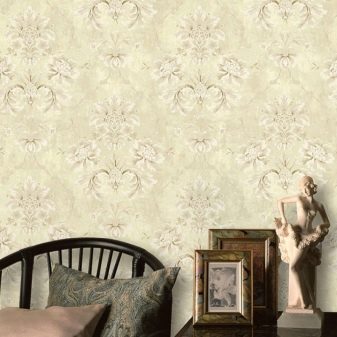
Experts call the main indisputable advantage of these paper finishing materials their environmental friendliness. Paper does not provoke allergic reactions, easily lets air through, this will not give a chance to develop fungi. An important plus of this product is its relatively low price.
It should be said about the defects that such coatings have. Paper is not considered a waterproof material, therefore wallpaper made from it is not designed for use in rooms with high levels of humidity. They are rarely found in the hallway or in the kitchen.
Designers highly do not recommend for pasting bathrooms. Surface care is also more complicated. Rubbing with a damp cloth will damage the paper backing.
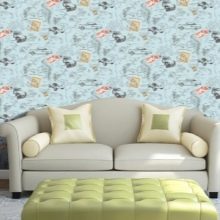
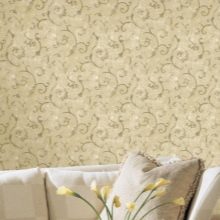
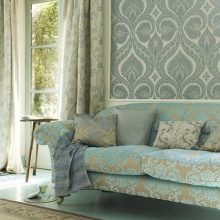
Non-woven
This is also a paper version of the coating, but it has a high level of resistance to damage, which is important in those apartments where there are children or pets. In general, this material looks prettier than ordinary paper wallpaper. They are denser and therefore require a special glue.
There are almost more of such wallpapers on the market of materials than paper ones. This is the current trend.
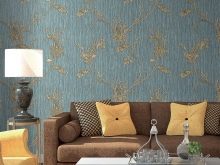
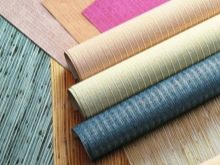
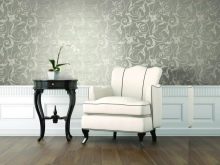
In building materials stores, as a rule, there are two types of such coatings. If we talk about the first, then the finishing base for the walls, consisting of non-woven fabric, is durable and looks great. Wallpapers belonging to the second type are similar to the first, but have only a non-woven base, while the wallpaper itself is created from vinyl. To understand what the properties of such a coating can be, you need to figure out what kind of material it is.
So, this is a fiber made of cellulose material combined with the help of glue with a special polymer composition, similar in quality to paper. The difference is that the non-woven material is stronger and has stronger refractory properties. From this material, wallpapers are created, which are made for painting. The paint will repeat the texture of the canvas. This combination looks amazing.
For repairs using non-woven models, acrylic or other water-based paints are best suited.
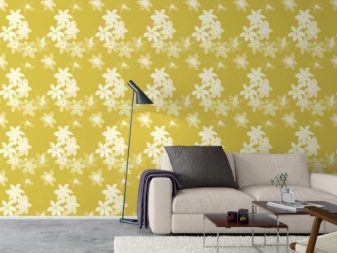
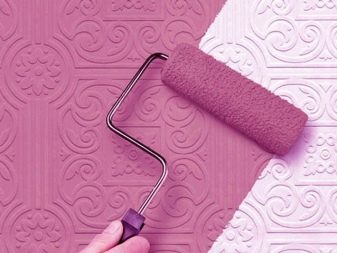
Non-woven wallpaper has excellent characteristics. They are made on a thick base, which means that by sticking them on the walls, you can close some flaws, get rid of cracks and bulges. Such models are difficult to ignite, this perfectly characterizes them as safe in case of fires and fires. They do not interfere with air circulation, so fungus will not appear on the surface.
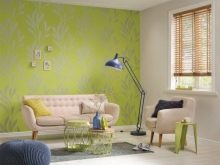
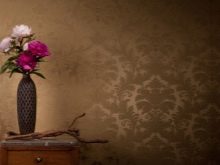

Textile
Thanks to this material, the decoration of the walls will become a feature of the apartment. Most often used if the room is designed in a classic style. The main disadvantage is a very high level of soiling. The only way to remove dirt is to glue on a new canvas. And this, as a rule, does not happen soon and requires new financial investments. And the textile finishing material itself is not cheap.
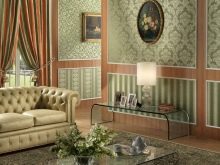
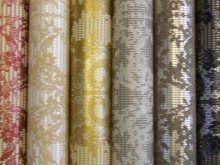
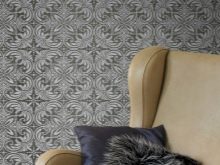
Velor
These wallpapers are based on paper on which nylon fibers are applied. They are suitable for almost any room, but in the living room they will be most effective. The process of gluing them is quite laborious. The glue should be rubbed with smooth movements with a cloth, the joints should be ironed with a brush.
One of the main qualities of velor wallpaper is soundproofing properties. The surface treated with this material shimmers like velvet. The material does not fade from sunlight, no matter how much it is used.
Interior designers often use this finishing method to give the room a special decorative twist, decorating and emphasizing the areas of the room.
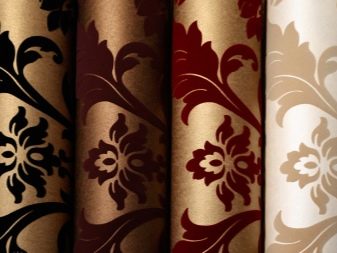
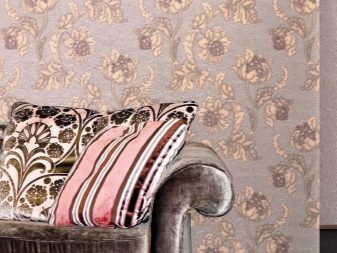
But they also have negative properties. The pile collects a huge amount of dust. The villi also absorb odors, and not just get dirty, but you only need to clean it with a dry method. In the event that a speck appears, it will not be easy to remove it. And, as mentioned above, it is rather difficult to fix these wallpaper canvases on the wall.
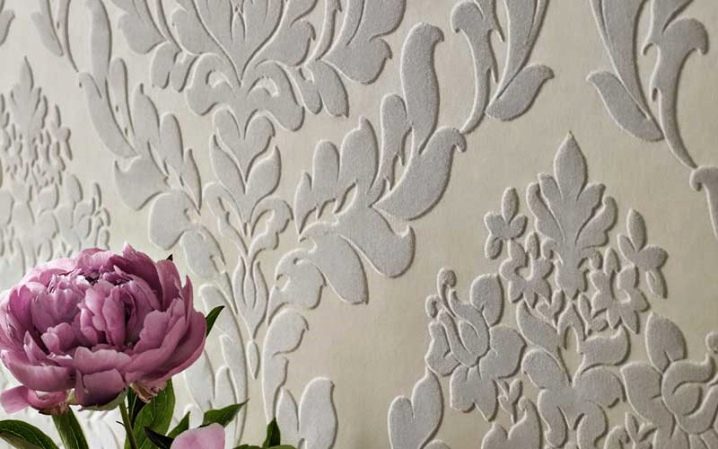
Vinyl
Along with non-woven, they are ahead of paper ones, since they are also moisture resistant. Most often they are glued in the corridor or in the kitchen, since it is there that a high level of moisture resistance is needed. But they are also good for the living room, because a large number of options, colors, patterns are offered.
They will be ideal in rooms where humidity is always present. This is a common problem of the first and last floors in multi-storey buildings, since the proximity of the basement to the boiler room and the roof, which can periodically leak, affects.
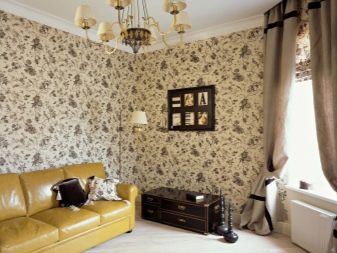
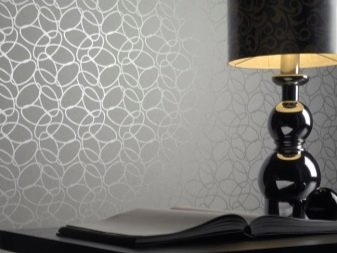
The finishing vinyl covering has the ability to be in excellent condition for quite a long time - up to twenty years. It is important to clean it with a damp cloth when caring for it. The widest range of colors, textures, ornaments is also considered an advantage. The wallpaper does not fade in the sun and is resistant to damage. Vinyl is great not only for decorating walls in the living room and hallway, but also in the kitchen, corridor.
Unfortunately, vinyl also has negative properties. Experts noted the release of vapors dangerous to humans, for example, methanol. On the packaging with a roll, as a rule, it should be indicated that the materials used in the creation are environmentally friendly and meet all requirements.
In rooms where the walls are covered with vinyl, it is best to open windows and doors as often as possible in order to ventilate the room.

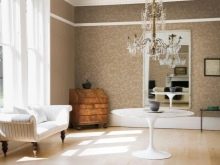
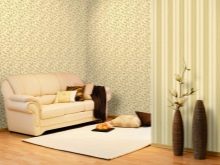
Another negative quality is that the pore layer, which is on top, began to be created relatively recently. If you buy wallpaper of old production, they will not allow air to pass through, which means that moisture easily accumulates under them. This contributes to the appearance of mold on the wall and on the wallpaper, including mold that is dangerous to human life.
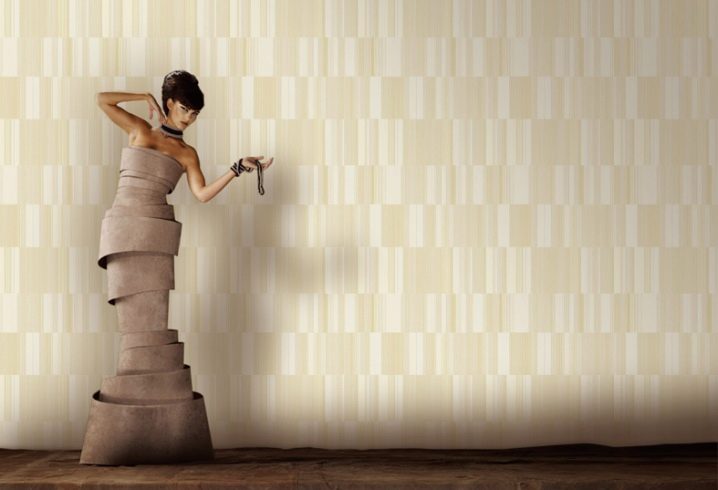
Liquid decorative plaster
Otherwise, such wallpapers are called liquid wallpapers. They are based on fibers made from special cellulose, they are absolutely harmless. The naturalness of the components is especially appreciated by modern people who care about the environment.In addition to other ingredients, the wallpaper contains a binder mass that has adhesive properties.
This type of wallpaper does not look like the classic one, but modern technologies allow the appearance of liquid wallpaper with the effect of silk, matte, textile, glossy.


There is no need to plan in which direction the light falls into the room, since liquid wallpaper has no seams. Apply the mass when it is ready, possibly not only on the walls, but also on the ceiling surface. In the process of work, the support of another person is not required, it is possible to cope with their application alone.
Another advantage, thanks to which customers love liquid wallpaper, is that there is no need to prepare the plane for a long time, which cannot be stated about classic wallpaper. If there are minor irregularities on the walls, it is possible to get rid of them with the help of the applied mass. The result is a high quality finish that is free from defects.


Reviews will undoubtedly help you figure out what qualities this finishing material has. So, for example, this is the ability of a material to pass air. Sometimes buyers believe that when gluing without seams, the plane cannot breathe, which means that fungi and mold have every chance of developing under it.
It is important to take into account that the cellulose base is very air-permeable, just as a result of this, you should not be afraid that the walls will become damp. This will free you from the greenhouse effect that is common in some rooms.
Reviews of a huge number of buyers point to the relatively expensive price of the coating as a disadvantage. But this is only true at first impression. The overrun of material in this case is practically impossible, due to the repair work, no waste remains. You can prepare exactly the amount of the mixture that you plan to use right now, which cannot be said about roll wallpaper. All these conditions force us to admit that the cost of such coverage turns out to be quite profitable.
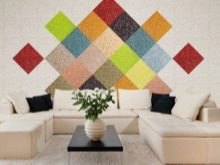

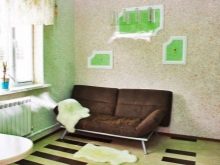
Wallpaper
This is a kind of paper and non-woven wallpaper, but with the difference that stunningly beautiful photo printing is applied to them. Thanks to the combination of photo wallpaper and ordinary in the room, you can achieve a delightful effect. More details about their combination in the interior will be discussed below. But now, photo wallpaper can be mentioned as one of the types of material that is used when renovating a hall or living room.
Although it is worth considering that wallpaper is used not only for this room. Often they can be found, for example, in the kitchen or in the nursery.
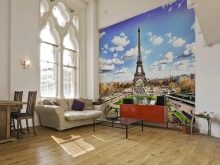
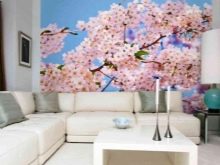
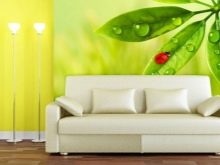
The liquid wallpaper
In fact, liquid wallpaper is a cross between standard paper wallpaper and decorative plaster. The mixture is based on viscose and cellulose, which are considered recyclable raw materials. The bonding element for the composition is glue. In factory-made products, antifungal agents are added to the solution, as well as various kinds of plasticizers. As the main fillers, the factories use waste from the woodworking industry in the form of cellulose fibers and cotton linen.
For the manufacture of expensive types of wallpaper, natural silk fibers are used. Additional decorative additives have no technological significance. These include: woolen threads, marble or quartz chips, mica sequins.

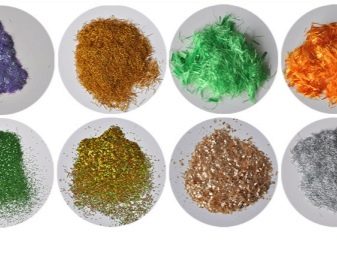
Dimensions (edit)
It seems that such a parameter as size is absolutely unimportant, but this is a misconception. Depending on the size of the roll, you can calculate how many rolls are required per room. Usually the dimensions are unchanged, but recently manufacturers have begun to produce options, the footage of which can vary significantly. You can read about these nuances in the article below, but for now it is worth considering such an important parameter as the width of the canvas.
The most common on store shelves are rolls of the usual standard sizes. There are, of course, all sorts of unique options, in a single quantity - handmade. There are much fewer of them, it makes no sense to dwell on their sizes, since each company individually produces a roll of a certain width.
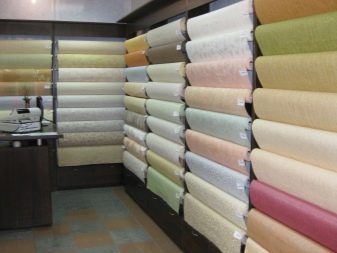
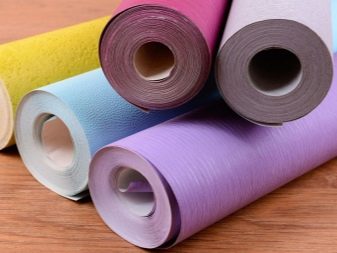
However, it is important to distinguish and mark two standard width options: half-meter and meter.
- Half-meter - are the most popular and well represented in retail chains in Russia. They are made in a wide variety of types, in large quantities, with textures and patterns. Their material is also very diverse. They are easy to transport. The main disadvantage is found already in the process of work. Due to the fact that they are rather narrow, a large number of seams form on the wall.
- Meter - they are rarely used in household repair work due to their considerable width. Such wallpaper is more difficult to transport - the weight of one roll is much higher than that of the previous version. But at the same time, finishing work with them is carried out at a faster pace, there are significantly fewer seams on the walls, often the cost of a wide roll with similar properties is lower than that of a narrower one.
Manufacturers offer customers unusual panel dimensions. It is worth saying that such "oversized" in recent years are found more and more often. They are released in leading European factories located in the territories of countries such as Italy, Belgium, Germany.
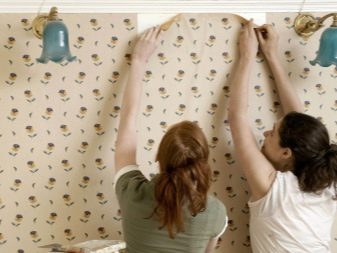
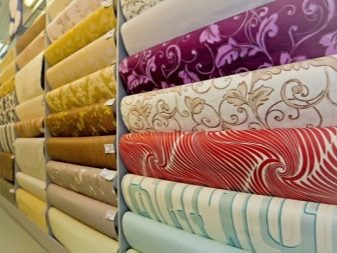
Now you should consider such a parameter as the length of the roll.
Before starting work, you need to find out the size of the surface that can be pasted over with a medium-sized roll. In Russia, such a roll length is considered ideal, which is 10.5 meters, otherwise 10 meters and 5 centimeters with an error in different directions, as a rule, take plus or minus three percent more.
Roughly in a roll 53 centimeters wide - 5.3 square meters, 106 centimeters wide - 10.6 square meters.
Based on these parameters, you can calculate how many rolls are required. It depends, among other things, on the height of the glued surface.
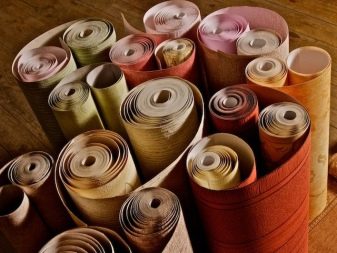

Not all designs are floor-to-ceiling taped. It so happens that you need to leave a strip at the top or bottom, where there will be either a different type of wallpaper, or a completely different material, for example, an artificial facing stone.
When using wallpaper with a rapport in work (this is how those pasting methods are called when the pattern is displaced) - two or three rolls will come out, but it all depends on the height of the walls to be trimmed.
Without displacement of the picture, only three or four sheets are spent, which is much more economical. When choosing a pattern, you need to take this into account.
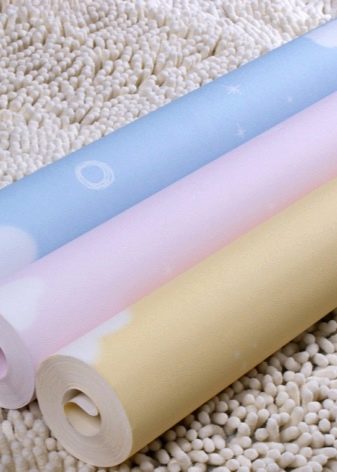
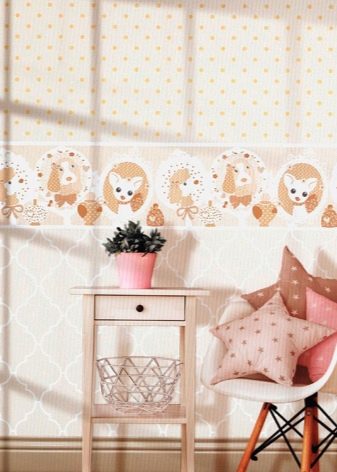
Extraordinary lengths are also produced. In this case, the rolls are 15, 20, 25 and 50 meters. Usually this is typical of materials for painting, the width of which is 106 centimeters, for example, "fintex" and similar products.
If there is a pattern, then there may be significant "waste" or it will be necessary to glue the canvases with your own hands, leaving a large allowance below. Due to the allowance, the edges of the canvases near the floor or ceiling can become uneven, this happens when trimming.
To hide this defect, you need to close the edges with a plinth from below or a special side on top.
By the way, the sides are made of the same material as the wallpaper and are sold with them in the same collection. Otherwise, in order to choose the right side for the selected wallpaper, you need to carefully look at the number of the selected wallpaper and compare it with the number of the side. By color alone, by eye, it is practically impossible to determine whether the side fits the wallpaper.
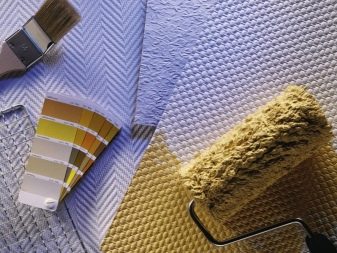

Colors and colors
The shade of the walls is of the utmost importance in the perception of the design of the entire room, so it is quite natural that sometimes several times more time is spent on the selection of wallpapers that are ideal, than on the pasting of the walls itself.Often, buyers spend a lot of time, effort and money to buy a roll of what they think is the perfect wallpaper, but as a result they realize that they bought the wrong thing.
In order to avoid such annoying oversights, it is necessary to choose the appropriate color carefully and deliberately, having analyzed many characteristics that can affect the visual perception.
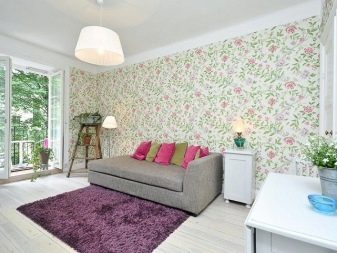
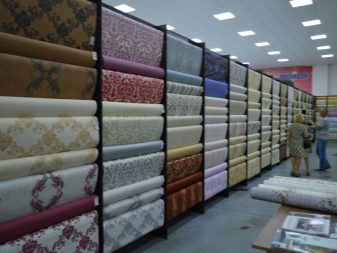
The modern building materials market offers any colors and colors of wallpaper: light, dark, lilac, white, brick-like, blue, purple, beige, yellow, solid, peach, gold, pink. The choice of finishing material for walls is limited only by the buyer's wallet and imagination, so it is more and more difficult to decide on the right color for decoration. Many buyers want wallpaper to transform a room into a spacious, cozy and stylish space.
Of course, you can ask for the help of specialists, they will be able to choose the shade of wallpaper for the room, but no one gives a guarantee that they will be able to predict the desire or preference of their customer. Therefore, the most reliable way to choose the right color for the walls is to personally study all the tricks of creating a color composition in the room.
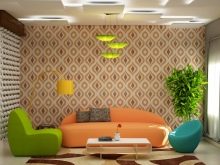
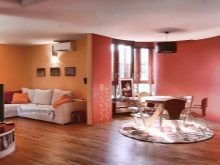
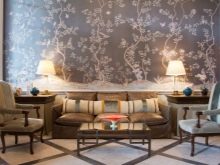
It is important to remember that a lot depends on the features of the premises that are planned to be decorated.
You need to follow many basic rules for the classic selection of colors:
- The peculiarity of the location and the number of window openings in the hall. The amount of natural light entering the room should determine the color and material of the wallpaper. In rooms with windows that face the north side, there is always a feeling that they are colder than they really are. In such rooms, a lack of lighting will be noticeable if you make a mistake with the choice of color. Therefore, it is better to choose warm wall colors: peach, beige, pink.

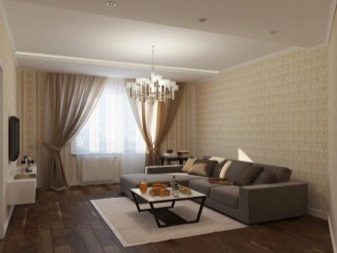
- The dimensions and layouts of rooms also influence the choice of wall color. Even the most spacious interiors are not always perceived comfortably, and small rooms, with the wrong choice of wallpaper, can form a feeling of crampedness. That is why it is fundamentally important to take into account all the characteristics of the rooms if you plan to make a design using different colors.
Colors for wallpaper in a small room should be selected as light as possible: beige, white, blue - an ideal choice in this case.
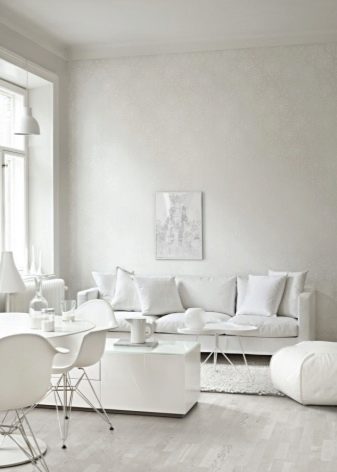
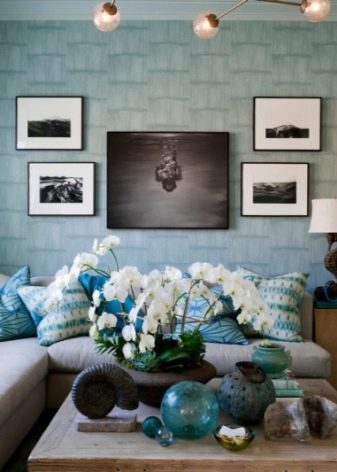
- The quality of the paints used in the design. This is the reason that has a direct impact on the "vitality" of the selected coatings. The better the paint, the longer it will last on the walls. Therefore, you need to use options for wallpaper with paints that are resistant to the influence of sunlight.
- Individual features of interiors. Part of the directions in the interior requires the use of a small number of colors, therefore, not always random selection of a shade for the main color in a particular room can serve as a guarantee of a harmonious style.

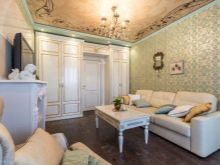
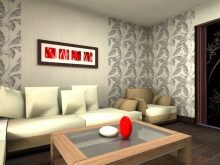
- Better to use and repeat the shades already used indoors. For example, the shades in which furniture, accessories, floor and textile elements in the interior are painted take an important place: in no case should inconsistency or excessive contrast of shades be allowed.
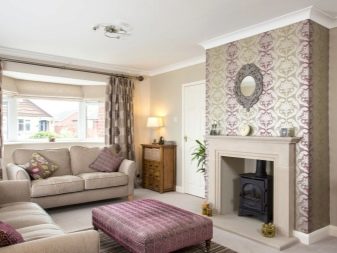

- When choosing a shade of decoration for walls, it is necessary to take into account other parameters. So, for example, an excessively bright color can contribute to the fact that emotional excitement arises, and this does not always suit some room interiors, for example, a bedroom. At the same time, a faded shade can be perceived well only in sunny weather.
- You need to heed the recommendations of experts. When you are not sure that ready-made wallpaper models will suit your interior well, designers advise purchasing wallpaper intended for painting.
It is easier to repaint already glued canvases in a different color than to re-glue. It will be more economical in terms of time and money.

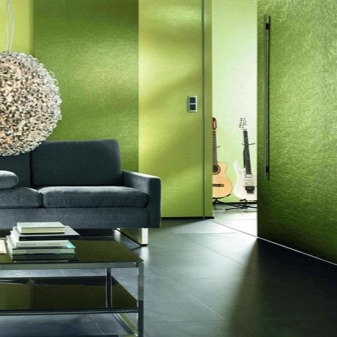
- If the room is used for several tasks at once, as is the case with living rooms, then it is better to choose pale or neutral color... It is necessary to consider some of the characteristics of color, which are discussed in the article below.
- As noted earlier, light shades reflect sunlight, therefore they are able to turn a room into a much brighter and more pleasant space to be in it. They visually increase the size of the room, personify cheerfulness and cleanliness.
Such wallpapers are considered to be optimal for use in rooms with almost any interior design.
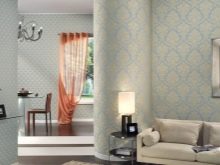
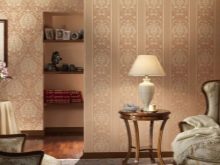
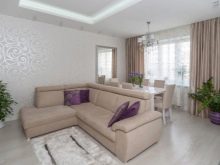
- Dark wallpaper in design, they are designed to create the opposite effects: to stop the movement of light, turn the room into gloomy and dark, reduce the space and exert psychological pressure on the subconscious.
It is better to dilute the cool color palette with more light and cheerful colors. Then the hall will be not only pleasing to the eye, but also stylish. It is dangerous to use only dark colors, as the room will look like a gloomy dungeon.
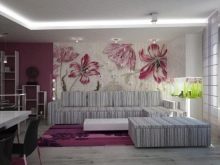
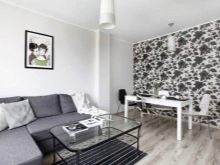
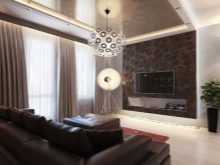
- Feng Shui is often used as a technique for perfect color matching of walls. It implies strict adherence to ancient traditions. Feng Shui experts say that yellow and green are optimal in the children's room, pink and burgundy in the bedroom, and white, black and red in the kitchen. But in the hall it is better to take white or beige tones.

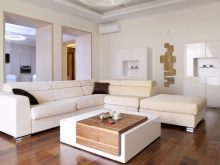

- For those who cannot choose just one color scheme, there are other options. Multi-colored wallpapers are becoming more and more popular, harmoniously combining and light, and black colors (as a composition or pattern). The classic black and white wallpaper is gaining popularity again, allowing to add contrast to the design of the room, which is sometimes so lacking in modern apartments.
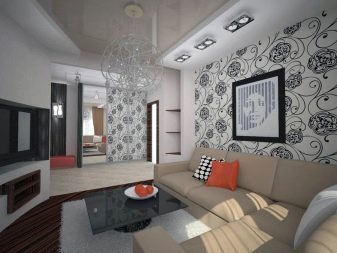
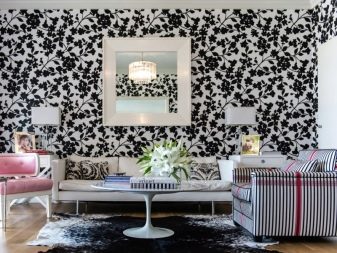
For the correct and ideal decoration of the interior decoration, experts recommend that you familiarize yourself with the psychological and aesthetic characteristics of the main and popular colors that are used to color the wallpaper.
- A sign of energy and striving for a set goal is purple tint on the walls. They can be applied to cutting-edge living room or kitchen interiors. In the bedroom, they will also look good. Lilac shades, on the contrary, have relaxing properties and do not make the design unnecessarily dark.
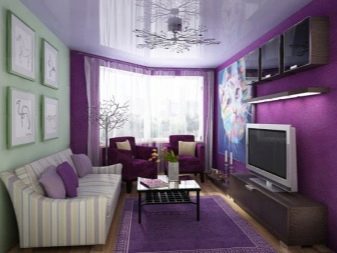
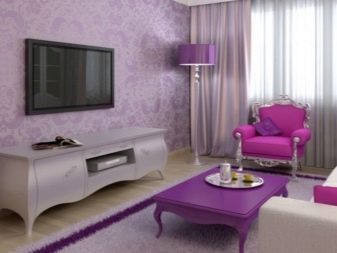
- Greenish wallpaper carry the beauty of natural natural nature. They are ideal for reproducing natural motifs and are suitable for almost any modern design because they match well with all colors.
Using them, you can achieve the greatest harmony if you take such wallpapers in tandem with woody elements or floral ornaments.
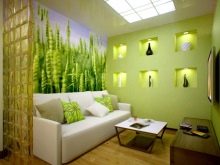

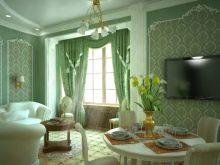
- Blue wallpaper - a gentle, deep sign. It symbolizes movement, energy, sea freshness. The color activates the awakening of fantasy, has a calming effect, despite the energy potential hidden in it.
Ideal for decorating a living room where the owners sleep at night. By the way, yellow wallpapers, as well as such shades as pistachio and turquoise, have a similar effect.
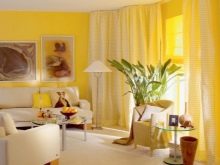
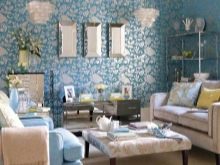
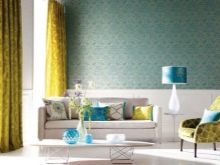
- Reddish and bright orange wall covering colors refer to the catchy color scheme. If they are used in an excessive amount in the interior, then it is fraught with overexcitation of those who are in the room.
This color has strong potential. Because of this, such shades should be taken only as accents when it comes to residential interiors.
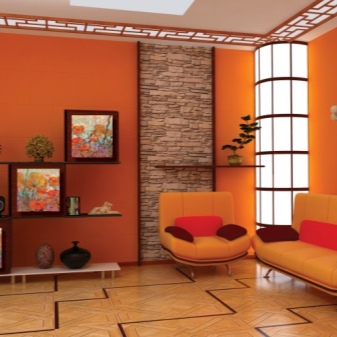
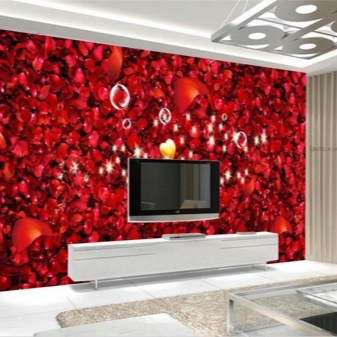
- They will help to make the space light, spacious, homey, gentle pink wallpaper coverings for walls. Moreover, this paint has long been not only for women. Combining with other colors can provide an elegant and contemporary wall decor.
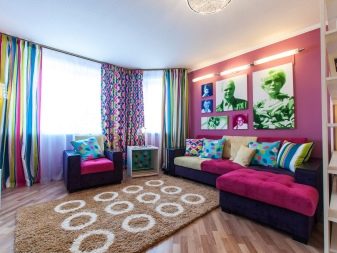
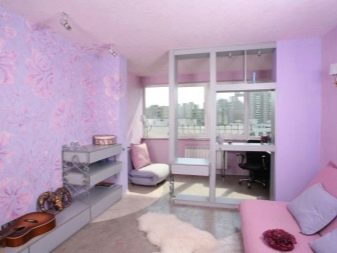
- Blue wallpaper - an excellent option for those who prefer creativity and are not afraid to use rich shades.Gives the room an additional effect of freshness and lightness. Suitable for the living room and some areas of the kitchen, bedroom and children's room. Often used for male adolescents.
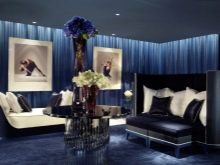
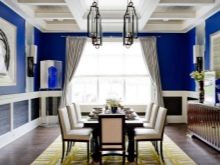
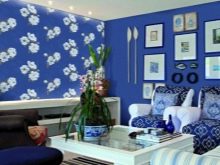
- It is considered universal gray tint: almost the entire palette of colors and styles suits it, and in the interior it does not exert the strongest mental pressure, unlike, for example, bright colors. In addition, it looks quite aesthetically pleasing if there is a lot of natural sunlight in the room. There is no need to be afraid to use it, referring to its gloom and dullness.

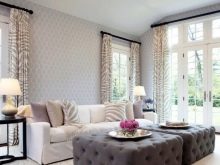

You don't have to stop at one color palette to ensure your design is complete. The main feature of any interior will be a high-quality and correctly selected combination of several colors.
At the same time, they can harmonize not only within the same plane - on the walls, but also in furniture sets, textiles, devices.
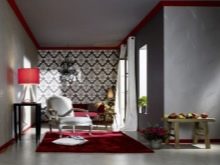
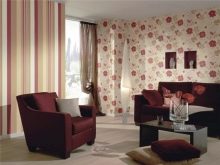
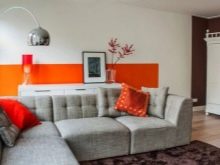
Choice of decor and decoration
You should pay attention to the fact that not all types of patterns fit equally well into the interior. Consider this when planning.
Experts identify the following types of decor:
- Flat and convex.
- Matte and glossy.
- With 3D effect.


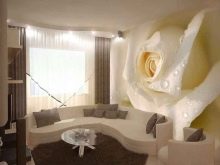
The difference lies in the method of application and the tools used.
Depending on the composition, the coating of the design can be:
- Silkov. Silk fibers create a specific pattern and give the material strength, resistance to abrasion and fading. The coating is pleasant to the touch.
- On paper. Such wallpapers are less reliable than the first ones, but they can be easily restored.
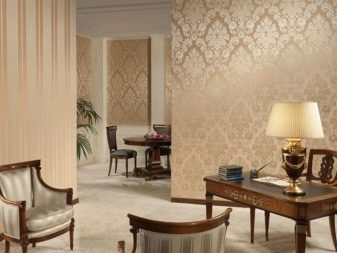
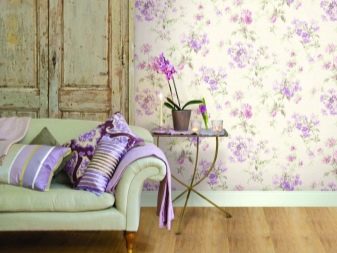
- Khlopkovhaving the lowest degree of abrasion resistance.
- Mixed. This type of material has unique decorative properties that depend on the type of additives.
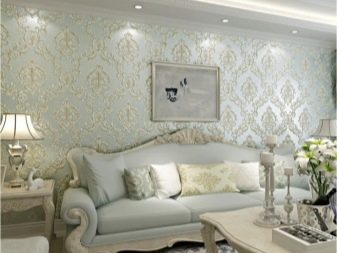
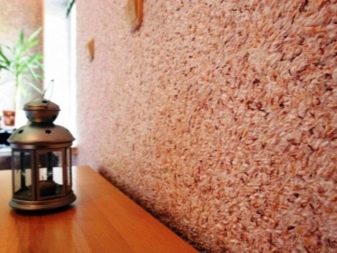
We decorate the walls with liquid wallpaper
- Liquid wallpaper allows you to equip any interior. A unique advantage is the absence of joints, which allows you to create seamless canvases.
- In the hall, fantasy is practically unlimited. Bright, fun colors are perfect here.
- A fashionable trend in the loft style can also be realized by applying liquid wallpaper "like a brick".
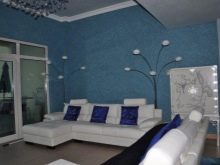
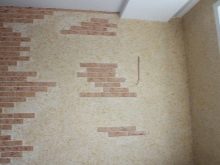
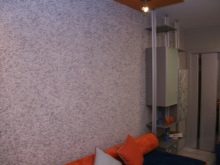
- Walls will look great if decorated with vegetation. Plants do not have to be life-size, you can make giant flowers or small spruces.
- Parts of the lounge are recommended to be decorated in soothing colors. For this, you can use landscapes, geometric or floral patterns. Experts advise against overloading such areas with drawings.
- If the design of the room allows, you can reproduce a stylish panel on the central wall.
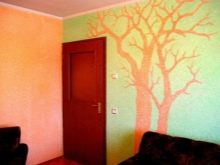
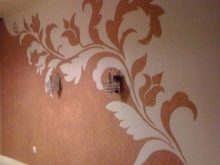
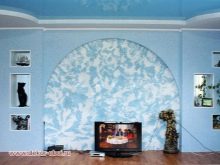
Stencils
You can create them yourself, but it's easier to purchase them at a hardware store.
The process of making a stencil with your own hands is simple:
- The image is transferred to paper using a printer and then transferred to cardboard.
- If the drawing is large enough, it should be divided into several parts. Print the elements, and then get a cardboard stencil, combining all the parts into one and outlining them.
- An easier option is to use the services of a copy shop, where it is possible to print large drawings.
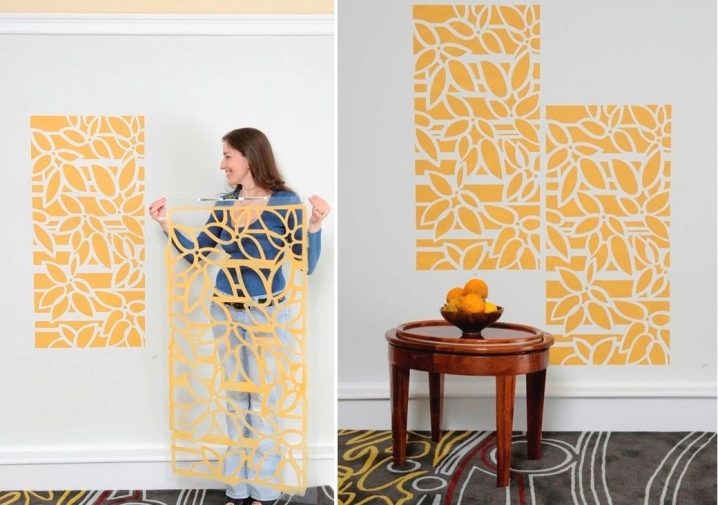
In addition to large stencils, small outlines can be used. To do this, the picture must be cut and inserted into the holder. With the help of a flashlight, a projection is created in a semi-dark room. The light source must be behind the stencil. By adjusting the distance between them, they achieve the desired size of the picture. The resulting shadow should be outlined with a pencil.
The decorating process consists of two stages. On the first one, the first preparatory layer of liquid wallpaper is applied. After it is completely dry, you can work on the drawing. The stencil is attached to the surface with masking tape. The mixture is filled in the space inside it. If you finish finishing at this stage, the pattern will be slightly convex.To achieve uniformity, a second background layer is applied to the wall behind the stencil.
Important: masking tape and patterns can be removed only after the material has set.
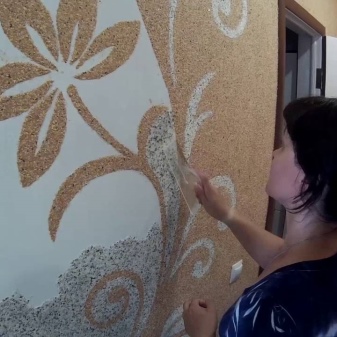
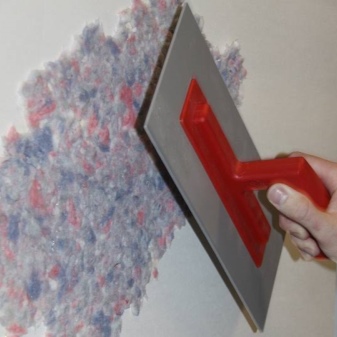
Free drawings
The method is more laborious. Moreover, the more color shades and textures, the more the drawing execution time increases.
The procedure is as follows:
- With a simple pencil, a sketch of the future drawing is applied to the wall, with notes on the colors of each section.
- The mixture is being prepared.
- Part of the composition is painted in the main shade and applied with a spatula within the boundaries.
- As the main part of the drawing dries, the other parts of the mixture are tinted.
- Further, the wallpaper is applied to those parts of the sketch that do not touch each other.
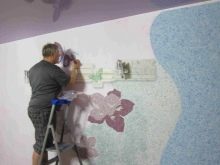
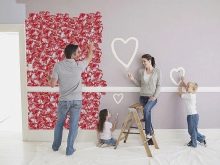
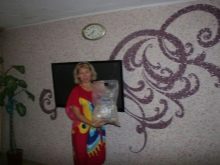
- With the help of a spatula and a construction knife, the drawing is edged.
- The material must dry before the next step.
- After that, you can start filling in other parts of the composition and adjusting those places where the wallpaper is uneven.
- Various strokes and contours are drawn with special markers or wax pencils.
- The final stage is drying for 1-2 days.
See below for more details.
Drawings on wallpaper
The hall and living room are a suitable place to experiment with colors and shades. This is where the use of both light and dark shades will be successful, since the design of this room is intended for everyday relaxation. At the same time, there is a need to create a certain solemnity, since it is in this room that guests are most often received. The design should be suitable for creating family comfort and home warmth.
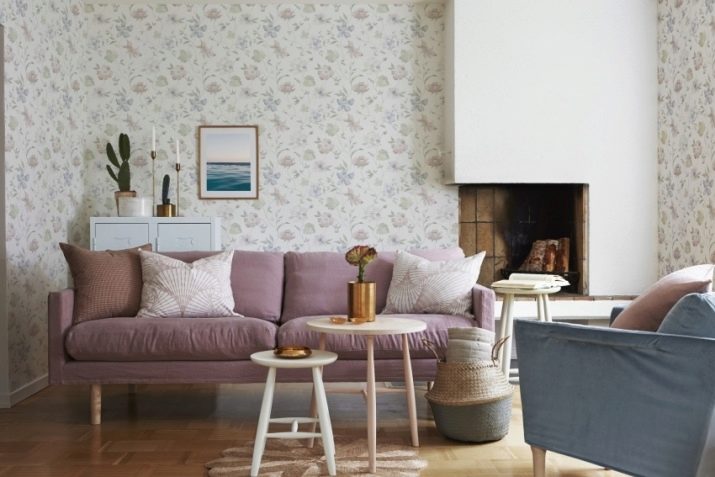

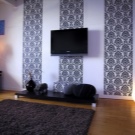
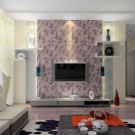
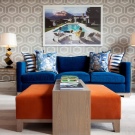

As mentioned above, a light color will make the room softer for visual perception. Here, a peach color option is possible, causing a persistent association with nature, which comes to life in the spring after hibernation, yellow. You can pay attention to the pattern on the wallpaper, where pink, blue, beige flowers will be used.
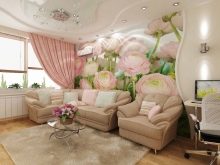
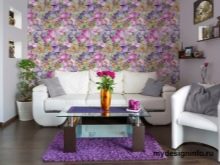
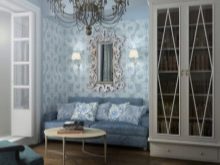
If the choice has settled on a dull color, you need to remember that an olive shade is often used in the hall: if the design is correct, it will help to emphasize the effects of an aged room. This effect of an artificially created aged wall is becoming more and more popular.

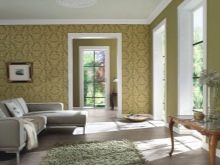
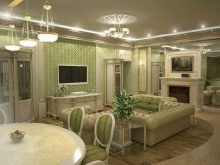
Want to use bright and contrasting colors indoors? Such wallpaper with a pattern is ideal for using an insert: they can be placed in so-called niches, placed on a free wall as a decorative panel. They can highlight a separate part of the room, thereby creating the zoning of the room.
The place where the sofa and the TV are located are often distinguished. It is not at all necessary to take a bright color with a pattern or pattern, it can simply be in sharp contrast to the main color of the walls.
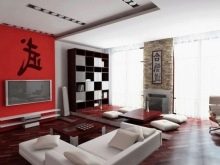
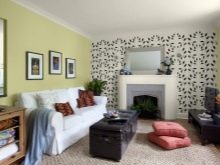
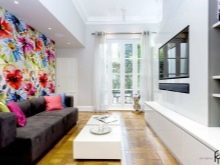
A similar effect can be achieved using a dark shade, but according to the advice of designers, they must be combined with more care than just bright colors. Dark is always a very strong accent, so you need to carefully choose the area that will be darker. It should be a perfectly flat, beautiful wall that you really want to highlight and emphasize. It is important not to overdo it and not turn the accent into the main color of the room. It is necessary to maintain a balance of dark and light colors in the interior.
There should be more light, according to many experts, regardless of the overall design concept.
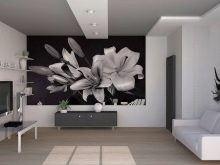
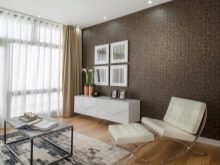

If you apply colors and patterns that are associated with spring, and these are warm colors: green, yellowish, orange, pinkish, peach to decorate the living room, then the room will become cozy and positive. True, they have a peculiarity - to induce a good appetite, therefore, such shades are often used to decorate the kitchen.
If the living room and kitchen are one space, as is the case in studios, then you can use this advice.

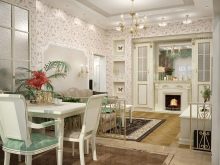
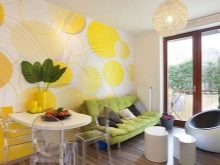
Light colors with different images are great for a corridor. Yes, walls can get dirty faster, but thanks to the light shade, any room will become significantly larger from a visual point of view. This is just necessary for small hallways or small living rooms.
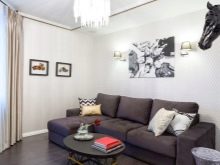
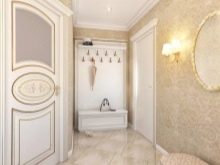
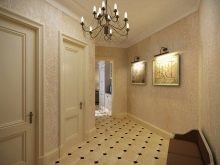
It looks pretty good to create an accent with wallpaper. This is done like this: three walls are made similar, of the same color, texture, and the last fourth is deliberately decorated with some noticeable spot. Wallpaper of a different color, or colors with a different texture or pattern, or those that have a pattern, but do not have a pattern on the other three, can play the role of a highlight. The latter option includes, for example, wallpaper. The option of combining wallpaper with some other finishing material is likely.
A designer can create a so-called stain only from color or from color and texture.
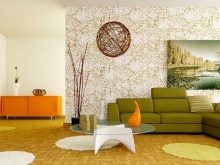
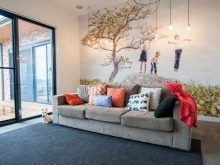
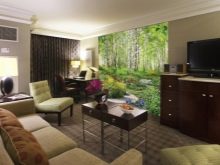
Style and modern design ideas
Wallpapering of surfaces is acceptable for almost all design styles. Armed with imagination, you can use them to create bright interiors, focus on individual architectural elements, reproduce silk panels and abstract paintings. It is worth dwelling on the most common and popular style options for living rooms.
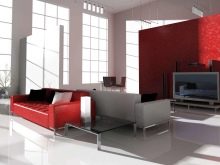
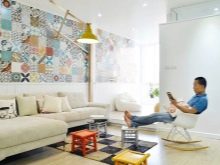
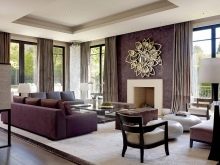
Minimalism
A modern citizen works with perseverance during the working day, therefore, once at home, he must have the opportunity to relax. The effect of relaxation is perfectly promoted by wallpaper in the style of minimalism: white wallpaper on the walls, delicate or pastel colors.
The brightest and extraordinary details or accents for such a design should be used as little as possible, a very sharp and contrasting shade transition between walls and furniture is unacceptable. This applies not only to the color scheme, but also to interior items.
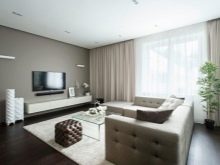


Classical
Traditional design implies light colors, now some designers especially pay attention to the fact that incomplete wall decoration is acceptable. A good option for a living room in a traditional manner is, for example, textiles.
It is important to remember that the material itself is very heavy, which is why significant difficulties can arise with its gluing.
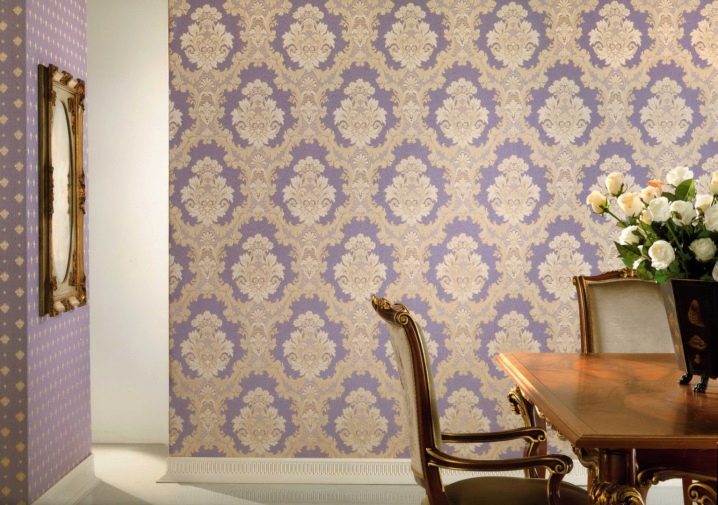
It is allowed to supplement the traditional design with wallpaper with the image of stucco molding, various murals or columns; it would be nice to use wallpaper with a design for magnificent curtains as accents. Traditional furnishings imply showiness, scale, must be combined with the walls in scale or according to the achromatic principle.
It is recommended for such a design to take plain vinyl or reed wallpaper with a dull pattern. Decorative plaster, called liquid wallpaper, will do. Cold painting on the walls is encouraged. It is permissible to apply wallpaper with a small pattern throughout the entire living room.
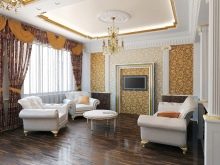
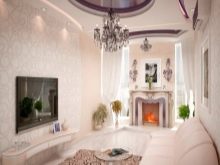
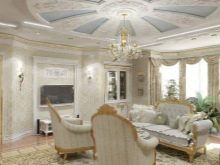
Baroque
When choosing wallpaper for such a style, rich colors are used: scarlet, yellow, coffee with ocher color. The structure of the wallpaper for the living room must be heavy. Ornate complex ornaments and floral, lace patterns look great in the design of the hall. Accents, all kinds of inserts are often used, which, as a rule, involve highlighting with frames or moldings. You can glue wallpaper depicting untreated plaster.
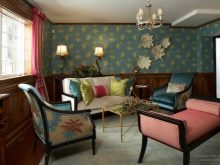
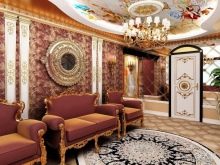
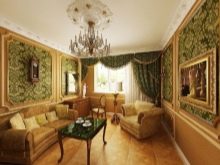
Rococo
Rococo is a direction that experts attribute to the directions of the Baroque style. Its distinctive features are richness, splendor and some playfulness in the design of the living room. Quite often you can see rooms decorated with pastel-colored wallpaper: pinkish, bluish, greenish.

For wall decor, as a rule, textile wallpapers with fractional ornaments, carved and stucco frames are used. In order to give shine to the coatings glued to the wall, silk or glossy material is used before painting.Wallpaper with stucco moldings of snow-white or gold color looks great in the interior of the hall.
It is recommended to smooth the transition between the wall and the ceiling using an elegant pattern (otherwise it is called a paduga), decorations like frescoes look great. The peculiarity of the style is the frequent use of mirror surfaces, gilded furniture details. Elegant rococo wallpaper for the hall is a great idea for those who love beauty.

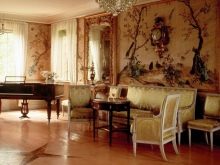
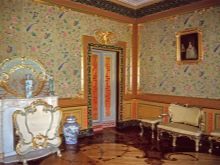
Modern
If the owner of the room wants to decorate it in the Art Nouveau style, you should pay special attention to the color. Saturated colors organically fit into such a design, but it is better to slightly muffle them with additional design, otherwise they will dazzle in bright light. The selection of color and light at the same time is important here. Walls with a pattern depicting, for example, an ornament on the skin of a leopard or other animal, look quite bright. Modern also means plant motifs on the wallpaper.
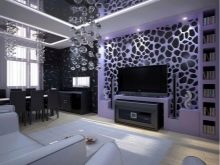

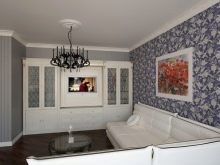
English style
Here it is better to take the finishing paint so that it matches the range of furniture as much as possible (preferably aged). Traditional British design implies almost unlimited number of monograms and ornaments.
In general, it is not at all necessary to create such a pattern in the size of the whole room - the designers believe that one or two walls, decorated according to the rules of the English estate, will be enough.

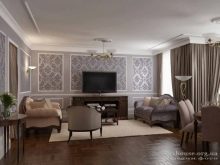
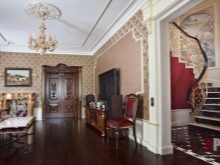
Provence
The famous southern French design is a collection of shades from a light pastel palette, it is usually devoid of ornaments. As a last resort, this is a design that has a discreet geometry as a pattern or a floral motif. The variety of colors is permissible and sometimes even looks better, but at the same time they should not stand out too much - the emphasis is still on muted tones.
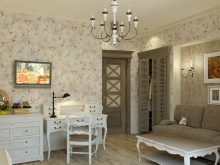

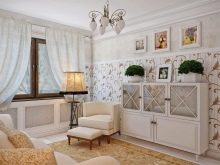
Black and white style
If we are talking about using only two colors, then, as a rule, designers use a combination of rich dark with snow-white. Two opposite colors go very well with each other. Sometimes it is possible to implement a design so that both shades are connected not in a straight line, as is usually the case with wallpaper canvases, but with complicated geometry at the joints. For example, at an angle or in a semicircle.

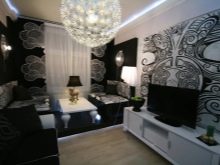
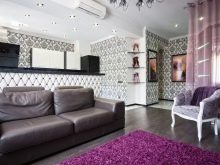
Which one is better to choose?
Many apartment owners strive to choose the right stylish wallpaper models in the right color scheme. Someone needs to find something for a small room to make it seem larger. Even for 18 sq. m, it is possible to select and arrange different types of wallpaper, which visually increase the appearance of the room. Transforming a room using only one wallpaper is not as difficult as it seems.
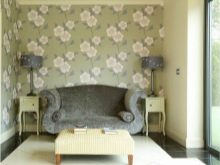
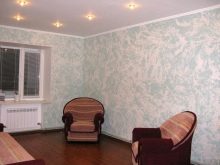
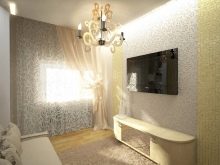
Interior designers know that when decorating an apartment with wallpaper, the perception of the interior decoration of a building can be significantly distorted. Amateurs should borrow a number of recommendations from them, they will undoubtedly help hide some visual flaws, or real defects in the walls, ceiling and other planes.
For a living room with a low ceiling, the dazzling brightness of the palette would be inappropriate. Here, by default, you should not choose a bright finish - it will put pressure on the mind. You need to choose something dimmer, lighter, less saturated. If the ceilings are rather high, then on the contrary, it is reasonable to add brightness. The size of the room will decrease slightly, but since it has high ceilings, there will be no “squeezing” effect.

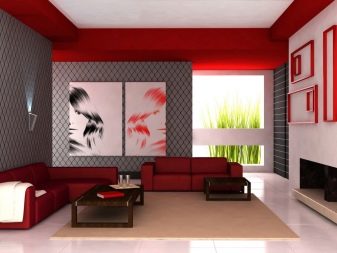
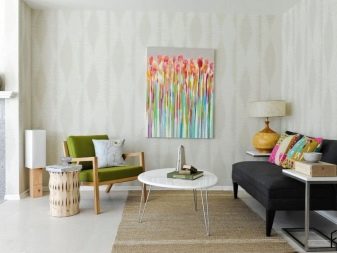
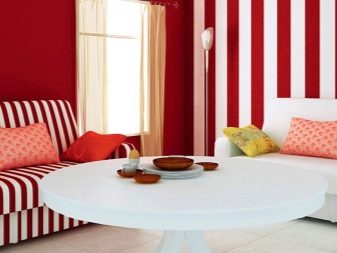
It is important to use small accents. They allow you to feel the size of the room. Giant living rooms should be decorated with plain coatings or canvases with large drawings, and for small rooms all sorts of monograms and small patterns will be an impeccable option. Large flowers on the walls are not appropriate for a small room.

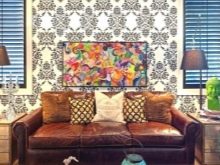
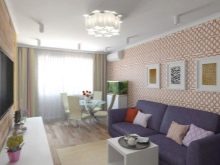
There is another way to visually enlarge the ceiling. This will undoubtedly be helped by vertical stripes.In this case, you do not need to strive for it to be bright, but they must be noticeable from any distance. You can use large stripes that will not be too contrasting.
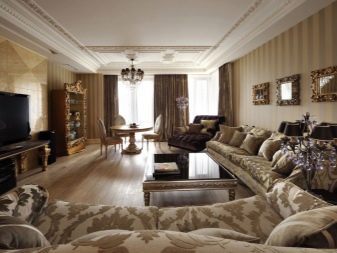
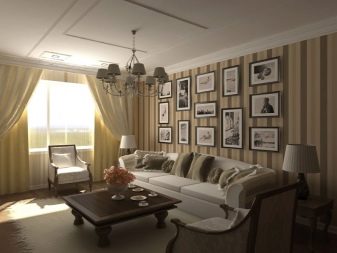
Famous manufacturers and reviews
The time has long since sunk into oblivion when in all apartments the walls were covered with the same type of wallpaper, which was produced by one or at most three firms. The modern market of finishing materials provides an opportunity to choose from a huge assortment. Designers closely monitor all new items. They are especially fond of Italian, French, German collections.
If a decision is made to use designer wallpapers in the interior, then you will have to pay a considerable amount, since they are practically piece goods and cost an order of magnitude more expensive than those that are mass-produced.
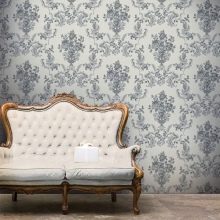
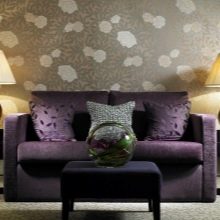
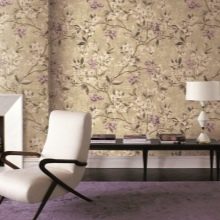
Russian manufacturers
Unlike foreign ones, our wallpapers have a low price. But this does not mean that there is no variety of choice or poor quality materials. But, apparently due to stereotypes, domestic brands are not popular. Usually they are purchased by people with middle and low incomes. Russian manufacturers include the following firms - "Palitra", "Moscow Wallpaper Factory", Art, "Saratov Wallpaper", "Praktik". Fairly good models are supplied by Russian manufacturers and factories from the CIS countries.

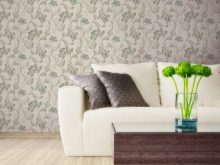
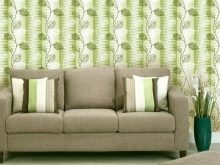
CIS countries
As a rule, wallpapers produced in the CIS are inexpensive and affordable. But not all factories can provide a large assortment. Koryukovskaya factory is the most popular manufacturer of Ukrainian wallpaper. The following products are delivered to Russia from the Koryukov factory of technical papers "Slavyanskiye Oboi", the "Vinil" plant (trade mark "Lanita"), "Versailles", "Argo". Belorussia supplies our market with "Beloboi", "Gomeloboi", "Dobroshenskaya Fabrika", "Hero of Labor" (subsidiaries of the holding). Now the enterprises have one of the leading positions in the market of finishing materials in the CIS.
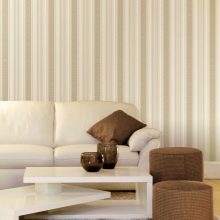
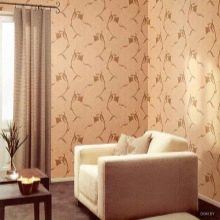
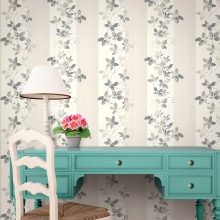
European brands
European brands are also widely represented in shops of finishing materials throughout the country, manufacturers in Italy, Germany. France, Sweden, Belgium regularly supply large deliveries to retailers. Finding the best European wallpapers gets easier every year. Among the most popular manufacturers are: Marburg Wallcoverings, AS Creation, Ca Samance, Ca Sadeco, Eco, Arte and Om Exco.
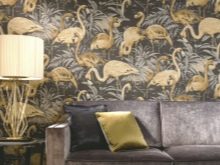
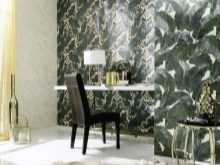
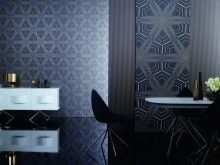
Companies from Europe, as a rule, produce a large number of those materials that can be classified as elite. They are usually on a thicker paper and fabric backing. Such coatings look very expensive on the wall, which is not far from the truth, since some models from European collections are much more expensive than those produced in Russia. Much cheaper are those options that are produced by the own facilities of European brands, but on the territory of our country. These include Rasch and Erismann.
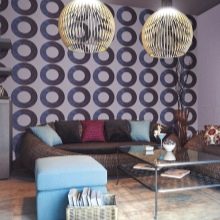
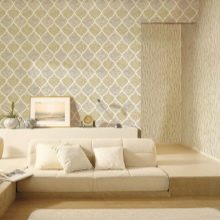
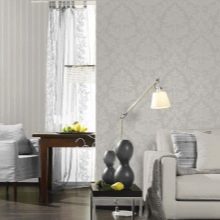
Advantages and disadvantages
Wallpaper has a number of advantages:
- Environmentally friendly, non-allergenic material. When covering the walls with wallpaper made of any material, no harmful odors are emitted.
- Due to its structure, the wallpaper provides additional noise and thermal insulation.
- Natural ingredients allow the walls to "breathe", which contributes to a comfortable indoor climate.
- Due to the anti-static qualities of the material, dust does not accumulate on the surface, which makes the air cleaner.
- Many wallpapers can be cleaned with a damp cloth.
- The product does not absorb odors.
- The finishing coating is fireproof.
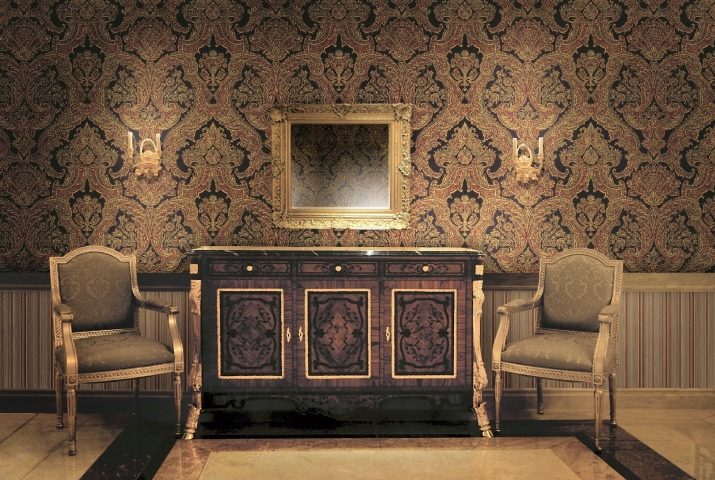
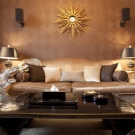
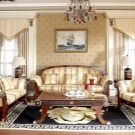
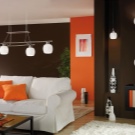
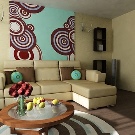
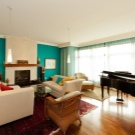
- The hygroscopicity and breathability of the material will eliminate the greenhouse effect.
- The wallpaper is resistant to fading.
- Repairs are greatly simplified, since most materials do not require additional leveling of walls and cracks.
- Wallpaper is perfect for finishing curved surfaces: bay windows, arches, rosettes, window sills, two-level ceilings and other complex architectural structures.
- When the walls shrink in new buildings, the layer will not crack or crumple.
- Conversion work is made easier by easily removing the wallpaper from the wall with a spatula. Experts assure that the old layer can be used again after processing. You can not remove obsolete material, but lay a new one on top of it.
- Wallpapers have excellent consumer characteristics: they are pleasant to the touch, have a beautiful and aesthetic appearance, thanks to the variety of colors and a wide range of textures.
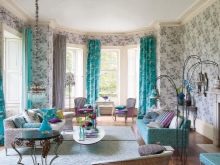
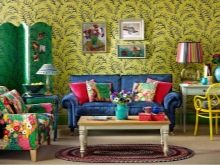
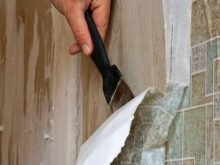
There are few shortcomings, but they also exist:
- If it is planned to carry out regular wet cleaning in the hall, then it is better to cover the surface of the walls with varnish.
- Pets like the softness and porosity of the structure, so there is a risk of being damaged by claws.
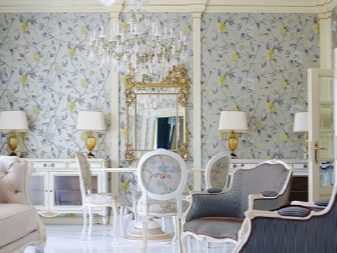
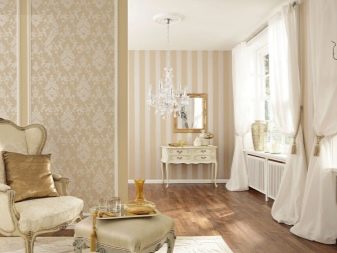
Beautiful examples and trendy finishes
- Avant-garde lovers will love bright geometric patterns that combine shapeless spots and clear multi-colored outlines.
- Loft lovers will appreciate the opportunity to create images of natural bricks, leather-like, wallpaper-partners and shabby plaster. Brick walls will look great in the hall of a studio apartment, so the living room will not seem empty.
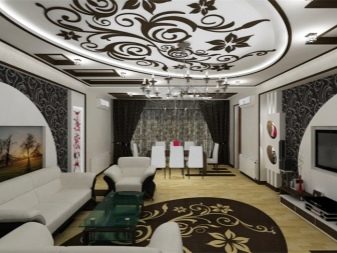

- A wide variety of Provence-style colors make wallpaper a favorite of this interior design. A wide range of textures and colors allows you to get various options for finishing coatings: from monochromatic pastel to delicate floral patterns.
Fluttering butterflies, singing birds and blossoming buds will add a touch of freshness and spring mood to the interior.


- Fans of modern styles with various technological touches will find interiors designed in hi-tech and modern styles. They can be used both in the "Khrushchev" and in the hall of a private house. Metallic colors are assumed here, with the addition of mother-of-pearl or mica chips. With the use of modern lighting elements, the interior will shine with "alien" lights.
Interesting Art Nouveau panels accentuate attention to detail and emphasize the design idea.
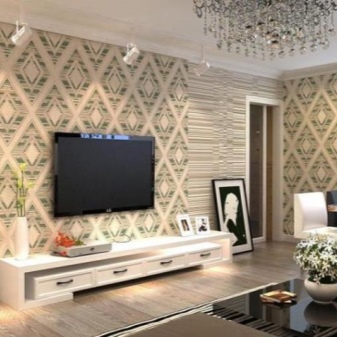
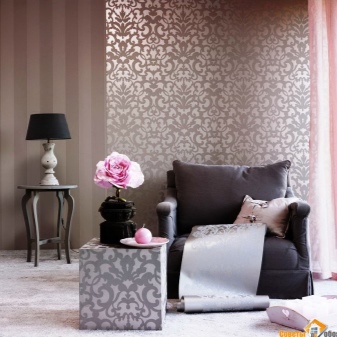
- Pink - peach wallpaper goes well with delicate pastel colors, orange and dark brown wall coverings, under which you can use red furniture.
- Beige walls are versatile, mixed with all colors of a warm palette, you can add a three-dimensional image to such an interior design.
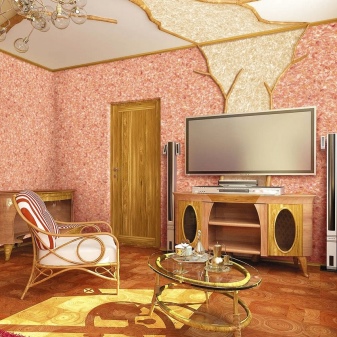
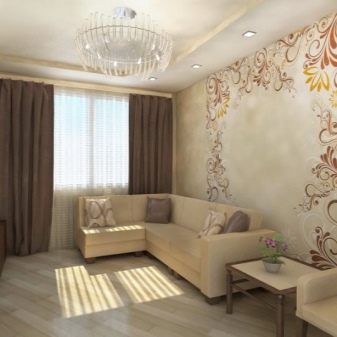
- Unique interior highlights are also created from monochromatic textures that expand the space, for example, liquid structural wallpaper will give a feeling of softness and chic.
- Experts do not recommend overloading recreation areas with drawings. However, having decorated all surfaces in soothing colors, you can focus on one of them in the form of a fantasy panel. Looking at him, a person will receive aesthetic pleasure and peace.
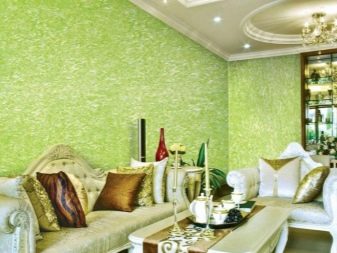

There are many possibilities of wallpaper. The main thing is to have dexterity, flair and artistic taste in order to use them. However, even in the absence of these qualities, it is realistic to make a breathtaking interior with your own hands. It is enough just to use the advice and recommendations of the masters, as well as instructions for manufacturing and technology.
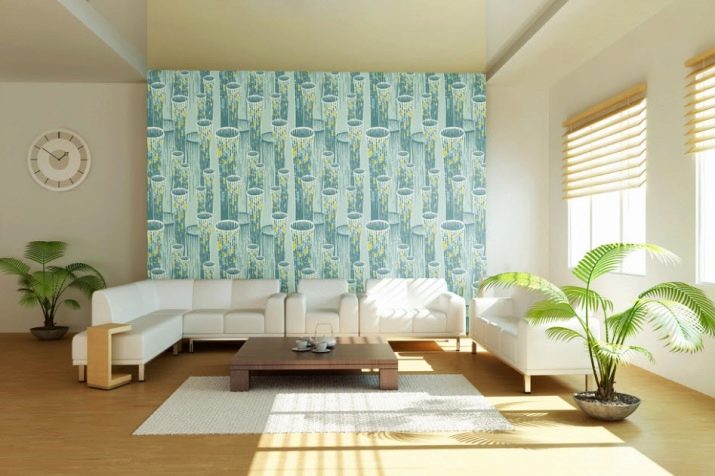
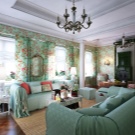
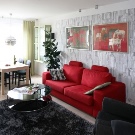
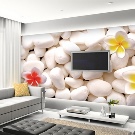
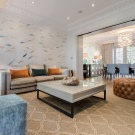
For more tips and tricks on choosing the right wallpaper, see the next video.













The comment was sent successfully.